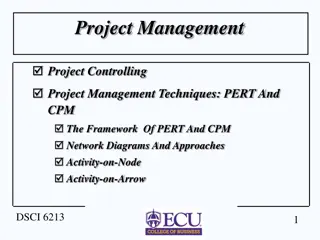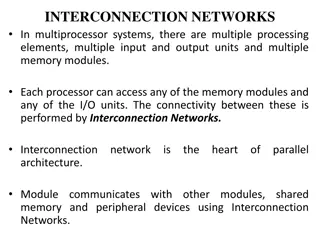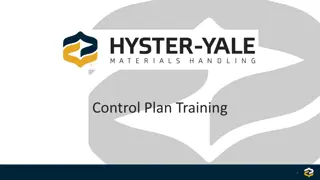Project Planning and Control Techniques: PERT/CPM Networks Overview
Project Evaluation and Review Technique (PERT) and Critical Path Method (CPM) are widely used project planning and control techniques, particularly for complex projects involving limited resources. PERT focuses on analyzing project scheduling problems using probability theory, while CPM provides a single time estimate. This article from Centurion University explains the key components of PERT/CPM networks: activities, events, merge and burst events, preceding and succeeding activities, and dummy activities.
Download Presentation

Please find below an Image/Link to download the presentation.
The content on the website is provided AS IS for your information and personal use only. It may not be sold, licensed, or shared on other websites without obtaining consent from the author.If you encounter any issues during the download, it is possible that the publisher has removed the file from their server.
You are allowed to download the files provided on this website for personal or commercial use, subject to the condition that they are used lawfully. All files are the property of their respective owners.
The content on the website is provided AS IS for your information and personal use only. It may not be sold, licensed, or shared on other websites without obtaining consent from the author.
E N D
Presentation Transcript
Lecture 15 & 16: Networks Introduction, origin and widely used networks Centurion University of Technology and Management, Odisha, India
PERT/CPM INTRODUCTION Any project involves planning, scheduling and controlling a number of interrelated activities with use of limited resources, namely, men, machines, materials, money and time. The projects may be extremely large and complex such as construction of a power plant, a highway, a shopping complex, ships and aircraft, introduction of new products and research and development projects. It is required that managers must have a dynamic planning and scheduling system to produce the best possible results and also to react immediately to the changing conditions and make necessary changes in the plan and schedule. Both the techniques use similar terminology and have the same purpose. PERT stands for Project Evaluation and Review Technique developed during 1950 s. The technique was developed and used in conjunction with the planning and designing of the Polaris missile project. CPM stands for Critical Path Method which was developed by DuPont Company and applied first to the construction projects in the chemical industry. Though both PERT and CPM techniques have similarity in terms of concepts, the basic difference is, PERT is used for analysis of project scheduling problems. CPM has single time estimate and PERT has three time estimates for activities and uses probability theory to find the chance of reaching the scheduled time. Centurion University of Technology and Management, Odisha, India
Planning: Planning involves setting the objectives of the project. Identifying various activities to be performed and determining the requirement of resources such as men, materials, machines, etc. The cost and time for all the activities are estimated, and a network diagram is developed showing sequential interrelationships (predecessor and successor) between various activities during the planning stage. Scheduling: Based on the time estimates, the start and finish times for each activity are worked out by applying forward and backward pass techniques, critical path is identified, along with the slack and float for the non-critical paths. Controlling: Controlling refers to analyzing and evaluating the actual progress against the plan. Reallocation of resources, crashing and review of projects with periodical reports are carried out. Centurion University of Technology and Management, Odisha, India
PERT/CPM NETWORK COMPONENTS: PERT / CPM networks contain two major components i. Activities, and ii. Events Activity: An activity represents an action and consumption of resources (time, money, energy) required to complete a portion of a project. Event: An event (or node) will always occur at the beginning and end of an activity. The event has no resources and is represented by a circle. The ith event and jth event are the tail event and head event respectively Merge and Burst Events: One or more activities can start and end simultaneously at an event Preceding and Succeeding Activities: Activities performed before given events are known as preceding activities and activities performed after a given event are known as succeeding activities. Dummy Activity: An imaginary activity which does not consume any resource and time is called a dummy activity. Dummy activities are simply used to represent a connection between events in order to maintain a logic in the network. Centurion University of Technology and Management, Odisha, India
RULES FOR CONSTRUCTING A NETWORK: 1. No single activity can be represented more than once in a network. The length of an arrow has no significance. The event numbered 1 is the start event and an event with highest number is the end event. Before an activity can be undertaken, all activities preceding it must be completed. That is, the activities must follow a logical sequence (or interrelationship) between activities. In assigning numbers to events, there should not be any duplication of event numbers in a network. Dummy activities must be used only if it is necessary to reduce the complexity of a network. A network should have only one start event and one end event. 2. 3. 4. 5. Centurion University of Technology and Management, Odisha, India
DIFFERENCE BETWEEN PERT AND CPM 1. PERT is probabilistic in nature. It acknowledges and considers the variability in completion times of activities and, in turn, the project. Accordingly it is useful for analyzing project scheduling problems with uncertain completion times of the activities involved. CPM is deterministic in nature. It is most appropriately used in projects in which activity durations are known with certainty. PERT is useful for projects that are new, non- repetitive, or which involve research and development while CPM is of great value for projects that are repetitive and standardized, like those involving construction activities. 2. PERT focuses primarily on time element and attaches lesser significance to the cost. CPM puts strong emphasis on cost and specifically considers the time-cost relationship and trade-off. 3. Whereas variation in the project time is inherent in projects when PERT is used, the time is systematically varied using additional resources where CPM is employed. 4. PERT is event oriented so that probabilities of reaching various events by certain dates may be calculated through event variances. CPM is activity oriented Centurion University of Technology and Management, Odisha, India























